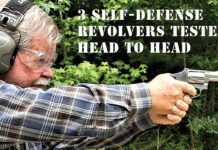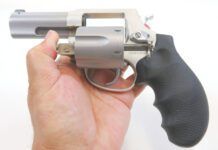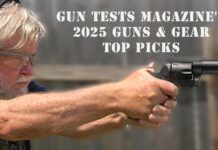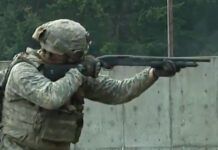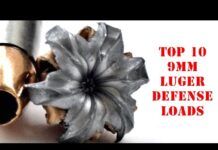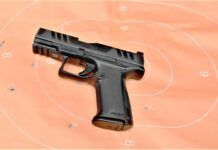The sport of Practical Shooting is a game with roots in self defense. The challenge is to not only land accurate shots onto scoring zones that could represent an incapacitating wound, but do so in the fastest time possible. Of course no one is shooting back, but speed is rewarded on the assumption that the competitor has determined a bona fide threat and fired first.
What makes the sport of Practical Shooting really interesting is that no two shooting matches are the same. But at any given event the shooter will have to draw from a holster, snatch the gun from a closed drawer or from a table top, and subsequently perform multiple reloads. You may have to fire from awkward positions or shoot while moving quickly. To accomplish these tasks, competitors modify their guns to make them more efficient, and for some time now manufacturers have incorporated these innovations into pistols that can be purchased “ready to race.” Three such makers that want to win are CZ USA, Springfield Armory, and Glock. The $679 Glock G34 has produced a lot of championships, and the $865 Springfield Armory 5.25 Competition is not afraid to challenge for top polymer pistol. CZ USA seeks to dominate with a steel-framed pistol, the $880 SP-01 Shadow Custom Exclusive. As a bonus we were able to acquire two additional variations on the venerable CZ 75 from the CZ Custom Shop, a closely related but separate entity from the parent company. They were the $1200 SP-01 Shadow Custom and the $1450 CTS-LSP. How much better would these guns be? The basic designs of these pistols were derived from popular service guns that have been reported on many times in the pages of Gun Tests and elsewhere. In this evaluation we’ll focus primarily on performance as it relates to the challenges of Practical Shooting.
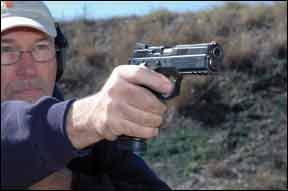
288
All five guns were tested for accuracy from the 25-yard bench. For support we improvised with a collection of sand-filled bags from http://www.bullsbags.com/. Designed primarily for the rifleman, their modular design has enabled us to adapt them for use with all types of firearms. Our test rounds were topped with the three most popular bullet weights for 9mm Parabellum ammunition. We used Black Hills’ 115-grain full metal jacket, Black Hills 124-grain jacketed hollowpoints, and 147-grain FMJ rounds from Federal American Eagle. For our practical-shooting evaluation, we enlisted the services of Joe Woolley, a veteran competitor with Master Class ranking in multiple divisions within the United States Practical Shooting Association. His company, F.O.R.T. Texas (Firearms Operation and Responsibility Training of Texas, http://www.forttexas.us/), specializes in making new shooters CHL ready. Woolley drove each gun through three of his favorite evaluation drills. First, he performed the Step Test, a non-timed drill for accuracy and precision. The target was a 12-inch diameter steel plate. Beginning at the 20-yard line, he fired one shot at a time. With each hit on the plate the shooter moved 1 yard further from the target. With each miss the shooter moved closer one yard. Next was the Double Tap. Beginning standing with the gun held at low ready (with the muzzle pointed at the ground about 5 feet ahead of the shooting position), he raised the gun upon a start signal and fired two shots in rapid succession at the 12-inch plate. Most targets in Practical Shooting require two consecutive shots, so the ability to control a forced pair is a necessity. Test distance for the Double Tap was 10 yards. In both of these tests, each gun was loaded with only 10 rounds because a limit of 10 rounds in the magazine is common to both the USPSA and IDPA rulebooks. We also wanted to gauge any change in balance as the weight and position of stored ammunition changed from 10 rounds to none.
Our third test was more complicated. Woolley snatched the pistol off a tabletop, then loaded and fired at two IPSC Metric paper targets 21 feet downrange and 15 feet apart. Prime scoring zones were the 5.9-inch-wide by 11.2-inch-tall A-zone in the chest area, surrounded by C and D zones, and the approximately 6-inch square head of the humanoid target. Moving left to right, he engaged each target with two consecutive shots to center mass. Then he reengaged left to right with one shot only to the upper A zone, or head area. Thus, he shot five runs with a maximum of six rounds. Start position was complicated by separating the magazine from the pistol with the hammer down or the striker spring relaxed rather than compressed and ready to fire. On start signal from a shot-recording timer, he had to pick up the gun, load the magazine and fill the chamber by working the slide against the full resistance of recoil spring and striking system. In each case the slide was released by the support hand coming over the top of the slide, grabbing it behind the ejection port and pushing the gun forward. That challenged the operator to pick the gun up and load it from empty, find a usable shooting grip, find the sights on target, fire a quick pair, steer the sights over a long interval, reacquire, fire another quick pair, and then find and readjust to a series of smaller targets. We simply wanted to find out which gun made it easier to get the job done. Regarding elapsed time, we paid particular attention to the first run and the best runs to see how quickly the pistol could be adapted to. Tests were completed without malfunction, except where noted. Now, let’s step to the line and listen for the start signal.
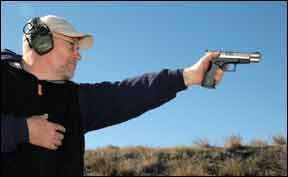
288
Glock Model G34 9mm, $679
If any 9mm pistol has dominated Practical Shooting, it is the Glock G34. The G34 is essentially a Model 17 with a 5.31-inch barrel and longer top end. The guide rod does not run all the way to the muzzle. It is captured by the slide just above where the single slot accessory rail ends on the dust cover. The G34 also had a low-profile windage-adjustable-only rear sight matched with Glock’s wide front sight blade. The rear notch had a white outline, and the front sight showed a large round white dot. Most competitors change to a rear sight unit that blocks more light and employs a thinner-gauge blade up front.
Other standard equipment that make the G34 more race ready than its stablemates include an oversized slide release, extended magazine release, and 3.5-pound disconnector, which provides a lighter trigger pull compared to service models listed at http://www.teamglock.com/. Our G34 trigger presented a 3.5-pound pull. We should note that the slide had a large rectangular hole on its top side just behind the front sight. This does nothing but lighten the slide, which reduces mass. Beyond a change of sights, there are several aftermarket modifications that are legal for competition.
One goal of these modifications is to shorten the distance the trigger needs to be released for the firing mechanism to reset. Changes in recoil springs and guide rods can also make the gun more efficient. The two supplied magazines held 17 rounds, but extensions that add five more rounds are available, too. There is no shortage of parts available for Glocks, including alloy-and-stainless-steel replacement frames. Catalog giant http://www.brownells.com/ is considering mailing a separate Glock-only circular, and there are entire small businesses set up around customizing Glock pistols. The gun is basically modular, but at this time the G34 remains a Gen 3 pistol with no plans for adding replaceable backstraps.
The main ingredient in shooting a Glock is learning to hold the gun steady as you press the trigger. You could say this about any pistol, but the grip shape and grip angle can take some getting used to. The trigger is not as long as some of the DAO pistols, but it has its own unique sense of compression.
In terms of accuracy, from the bench the top performer was the Black Hills 115-grain FMJ rounds. If it weren’t for one five-shot group measuring 2.5 inches center to center, our groups would have ranged in size from 1.0 inch to 1.4 inches wide. The 147-grain American Eagle FMJ rounds averaged about 2.1 inches for five shots. The Black Hills 124-grain JHP rounds were better, with groups about 1.8 inches across.
Joe Woolley has used a Glock 34 to compete, but he switched to an S&W M&P more than two seasons ago. It was not represented in this test, so we thought he was capable of making a fair comparison of the remaining guns. But performing the step test did bring back old skills suited to the Glock. He didn’t miss any shots out to a distance of 30 yards. Many of his hits were dead center, but they trailed low and right on the final few shots.
The Double Tap test required a smooth first shot and a release that did not over extend because the second shot on a Glock can be accomplished with a shorter press if you pay attention to point of reset. Letting the trigger move fully forward, or worse, losing touch with the face of the trigger, can result in jerking the muzzle downward or out of line. Visually, our test shooter was able to track the front sight rising and falling between shots in an elliptical motion at an angle from rest to a point somewhere between 1 o’clock and 2 o’clock. A somewhat cautious first run yielded a first shot beginning 1.23 seconds after the start signal with a slow 0.37-second split time. By the third pair the first shot registered before 1 second, and the final two pairs were nearly identical, scoring a first shot at the 0.86 mark followed by a .28-second split. All hits registered on target.
One modification to the pistol that would have made a huge difference would be applying grip tape to suit the contact points of the shooter’s hands. The added grip inspires confidence, and shooting double taps relies on confidence as well as precision. Cutting up a $7 sheet of grip tape and pasting it on the Glock probably would have been a good investment.
In our load-and-shoot multiple-target tests, we were able to score the hits as well as read the timer. We were looking for 10 hits to the lower section of each target and five hits to the head area. Target left, or T-1, was engaged first and showed 10 hits scoring 3 A’s, 6 C’s strung vertically to the left of the A zone, and one more C high of the A-zone. Target right, or T-2, showed 7 A’s, a C-zone shot to each side, and a single D-zone hit. Both targets had showed all five shots delivered to the head area. Start signal to first shot took 2.57 seconds on the first run with a total elapsed time of 6.08 seconds. The last two runs were very close, with the best overall run beginning at 2.33 seconds after the buzzer and ending after 5.20 seconds. Our test shooter reported that he was aware of, if not distracted by, the gun’s torque on recoil as described earlier. Naturally, an off-center track takes more time and effort to recover from. Some of the aftermarket recoil-system parts address this issue directly. We could have saved much more time using a different initial loading procedure. The over-the-top method is not necessarily the fastest method, but it works every time on any type of pistol. Had we chosen to simply depress the Glock slide-release lever upon loading, we could have saved a huge chunk of time. The Glock was much more eager and able to close using this method than any other of our pistols save the Springfield Armory 5.25, which was a close second in displaying this characteristic.
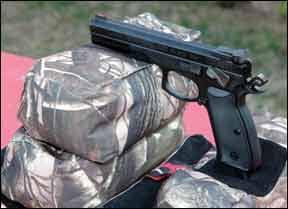
288
Our Team Said: Not too long ago most shooters agreed that you can either shoot a Glock well or you should ignore it. But Glock pistols have worked their way into shooter’s hands by being economical and therefore accessible. The G34 is a quick, easy way to get into competitive shooting, with a long list of aftermarket parts to make it even better.
Springfield Armory XDM 5.25 Competition
Bi-Tone No. XDM95259SHC 9mm, $865
The XDM series is a mix of European and American design. Both the XD and XDM pistols are manufactured in Croatia, where the XD racked up an impressive record as the most widely used pistol in law enforcement. The M series seems to reflects changes according to the desires of the American shooter. In terms of safety the primary change was the gun can now be disassembled without pressing the trigger. This trumps the Glock design as well as the XD pistol. The grip-safety feature was carried over to the M series, and so was the easy takedown procedure that begins with rotating the lever on the left hand side of the pistol. Overall, the XDM is a much better looking pistol, too, our testers said.
The grip frame of the M was longer and flatter than the XD, and this accommodates a higher-capacity magazine. We think this new profile was developed in deference to shooters who prefer the 1911, an American design. The XD offered a wonderfully skinny circumference from the rear of the trigger guard to the deepest part of the undercut grip. This trim line is still in place on the XDM, but unlike the XD, the grip stays trim and flat all the way down to the bevel molded magazine well. The flat-sided grip aids directional index and stability. The backstrap is removable, and three alternate sizes are supplied. Slipped into place from the bottom and held by a roll pin, we found the medium-size plate number 2 was suitable for each member of our staff. Other extras were an airline-quality attaché case filled with a belt slide holster, dual magazine pouch, two extra 19-round magazines, the obligatory cable lock, and a very well designed magazine loader.
The XDM pistols are available in a number of sizes and colors. The XDM 5.25 Competition sports the longest barrel at 5.25 inches in length. Ours was the Bi-Tone model, which featured a forged stainless-steel slide with satin finish. The all-black model comes with forged-steel slide with Melonite finish (MSRP $795). Since we acquired our 9mm pistol, the 5.25 Competition series has expanded to include chamberings for 45 ACP and 40 S&W. All XDM models feature a fully supported, ramped barrel. The Competition series pistols come with a Match Grade Select Fit barrel. Springfield Armory uses the term “fitment” to describe their methodology for applying a match-grade fit. According to Springfield Armory’s Custom Shop, the barrel for each pistol “is selected from several oversized barrels for the best fit in that particular pistol.” National Match barrels that require greater fitment are also available from the Custom Shop. The Springfield Armory Custom shop offers three different packages for the XD/XDM pistols, and 35 different services, including trigger work that lowers resistance and shortens reset. We thought our pistol’s 4.75-pound trigger was less an issue than its longish reset.
Another innovation that separates the M series from the XD is the rear sight face, which matches the very end of the slide for maximum sight radius. It also has a light-gathering-filament front sight dovetailed into place. The fully adjustable rear sight was so deeply countersunk into the slide that the hinge of its elevation adjustment was accessed through the slide. Like the Glock 34, the slide has been lightened by a cutaway on top of the slide between the ejection port and the front sight. The Glock slide is wider than the XDM, which seems almost spindly in comparison, so the relief is much longer. But both cuts relieved about 1.39 square inches of mass. The XDM slide weighs 12.0 ounces versus 13.1 ounces atop the G34. Underneath was a hollow steel guide rod and long coil spring. The guide rod was only about 0.3 inches longer than the Glock unit, but was more difficult to install. The flat wire spring of the Glock was captured, but passing the XDM guide rod through the long spring into the bottom of the slide was a challenge. However, accessibility to the spring makes experimenting with recoil spring rates a much easier task.
From the bench, the XDM appeared to favor heavier bullets. While averaging about 2.4 inches per five-shot group firing the Black Hills 115-grain FMJ rounds, better results were achieved firing the 124-grain hollowpoints and the 147-grain rounds averaging 2.1 inches and 1.9 inches respectively. In our Step Test Woolley suffered a single miss on his third shot, with the bullet flying directly over the target at 12 o’clock. Sight track was consistently straight up and down. Initial attempts at the Double Tap test also put shots directly over the top of the plate. After learning to control the XDM, which our test shooter had not previously encountered in any form, all first shots rang out less than 1 second from the start signal, 0.91 being the fastest on target. Second shots split times hovered consistently at the 0.29-second mark.
In the multiple-target tests, the very first run was the fastest, taking 2.30 seconds to the first shot, (this later improved to 2.25 seconds), with a total elapsed time of 5.17 seconds. The score on the left side target (T-1) was 4 A’s, 3 C’s and a D left of center and two C’s right of center. The head area showed all the hits along the center line, but one shot was too high. Hits on T-2 showed all hits comfortably in the head area and a group of 7 shots in the A-zone. One was a little low of the A-zone and the other two were C-zone hits just right of center.
Our Team Said: Whereas the XDM 5.25 is more expensive than the G34, one of the more costly upgrades, high definition sights, was already in place. So is a standard guide rod and recoil spring system that’s easier to work on than a sealed unit. Experimenting with matching ammunition to recoil spring rate is a common first step to race setup. It shouldn’t be long before competitors and shade tree mechanics have this gun tricked out. For example, with the grip safety in place we would be less hesitant to have the trigger lightened considerably than other DAO-type pistols.
CZ USA 75 Shadow SP-01 Custom Exclusive No. 91154 9mm, $880
It is ironic that the man generally recognized as the father of Practical Shooting, Colonel Jeff Cooper, was a diehard 1911 shooter but also publically admired the (then) Czechoslovakian-made CZ pistols, which featured a double-action first shot as well as single-action cocked and locked carry. However, the rules say that no pistol competing in USPSA Production Division or IDPA Stock Service Pistol can be a full time single-action pistol. At least the first shot must be double action. The biggest challenge for the DA/SA type pistol that transitions automatically from double action to single action by movement of the slide is to make a smooth transition. Thumbing the hammer on the draw or wasting a first shot just to get to the faster overall operation of the single-action trigger is not acceptable. Enter Kansas City-based CZ USA and their alliance with the CZ Custom Shop, in association with Ghost Products in Mesa, Arizona. Whereas CZ USA has been importing guns for competition, http://www.czcustom.com/ provides the types of upgrades that only world-class competitors have been able to devise.
Our Custom Exclusive was smoothed out by the custom shop, compared to the No. 91153 Model SP-01 that is sold factory fresh. The model series SP-01 can be described as a model 75 pistol with a long dust cover frame that also serves as an accessory rail. The Shadow pistols are enhanced with a fiber-optic front sight and a higher-definition rear sight that extends further rearward to increase sight radius. The CZ 75 Champion-style hammer is used because its shorter hammer hooks decrease the amount of time they stay in contact with the sear. This lessens resistance. The CZ 85-style slide is used without the firing-pin block. This speeds trigger reset. The CZ 85 trigger offers overtravel adjustment, and the trigger guard is undercut to seat the pistol lower in the shooter’s hand. This adds control. A lighter recoil spring is applied to reduce muzzle dip as the slide slams shut. Wider thumb safeties commonly found on the single-action-only CZ 75 SA are used. An extended magazine release is installed. All the CZ 75-based competition guns come with 18-round magazines and floor plates that wrap around the bottom of the magazine body and continue the contour of the grip.
Takedown of an empty SP-01 is performed by moving the slide rearward about 0.2 inches (to match the guidelines scribed into the frame and slide), and removing the slide-stop pin. The snug fit of the slide stop pin is a necessary component of lockup and accuracy, but the pin is not so tight that a rap from the bottom of a magazine can’t move it far enough so it can be pulled manually from the frame. Opposite of most semi-autos, the CZ frame rails reach up over the slide rails.
The DA/SA trigger pulls on our pistol weighed 8.5 pounds and 4.0 pounds respectively. Devotees of the DA/SA trigger argue the superiority of this system, because in a match with say five courses of fire or scenarios, the double-action trigger is only going to be used five times. But over the course of five runs the competitor may use the light quick-resetting single-action trigger 100 times or more. At the bench all shots were fired single-action only and the results show the value of the SA trigger. All but three groups overall, one per choice of ammunition, measured 2.0 inches across or greater. Average group sizes for the 115 grain, 124 grain, and 147-grain ammunition was 1.8 inches, 1.7 inches, and 1.96 inches respectively. The Step Test was also performed single-action only, and there were no missed shots. But two failures to feed were traced to a faulty magazine, which allowed rounds to nosedive rather than exit at the proper angle.
Our SP-01 arrived with the full-contour rubber grips. These are base-model standard equipment grips, but they suited our test shooter just fine. Hand-to-gun fit is extremely important, probably more so when shooting a DA/SA pistol. That’s because only a solid grip will help the shooter ignore the transition from double-action first shot to single-action fire. It also helped that the gun sat low in the hand, keeping muzzle flip to a minimum. But the time between runs on the Double Tap drill was longer because the hammer had to be reset to the half-cock position before every run. This was accomplished by grasping the hammer in its rearward position, then pressing the trigger until we felt it release accompanied by an audible click. At this point you must continue to hold back the hammer. But once you’ve heard the click of the trigger and removed your finger from inside the trigger guard, the hammer can then be lowered safely until it catches in the half-cock position about 0.4-inch from the firing pin. For those hesitant to manually decock the hammer, the SP-01 Tactical adds a manual decocking lever. But it is generally recognized that a more refined transition from double- to single-action fire can be achieved with the traditional action.
The initial run registered a double-action first shot at 1.11 seconds and a second shot completed the drill at 1.42 seconds. Runs number four and five were nearly identical, with a 1.01-second first shot and a 1.27-second followup shot. Best split time was 0.25 seconds. But since we have already established that most shots with the CZ would be fired single-action only, we decided to try the Double Tap drill again without the burden of a transition. First-shot elapsed times ranged from 0.99 seconds to 0.71 seconds. Total elapsed times varied from 1.25 seconds to 1.02 seconds. The best split time measured 0.18 seconds, and there were no missed shots. Regarding any change in control due to weight transfer as the magazine emptied, the SP-01 pistols suffered the least, in our opinion. The lighter-framed polymer guns showed more effect, but there are several ways to address this. Change in ammunition, recoil components, and quality of grip can greatly reduce the overall effect.
In the multiple-target test we saw times drop from an initial run of 5.22 seconds overall with a 2.81-second first shot to a best run of 4.45 seconds, with a 2.27-second first shot, on the fourth run. The reason given was time needed to get used to the trigger. Since the gun was charged from the table top, all shots were fired single-action only. Shouldn’t this had been an advantage right away? It certainly would have, in our opinion, if the SP-01 was our full-time gun. In that case the shooter would have fully expected to engage a trigger that demands fine motor skill. Keep in mind that in the other tests, the shooter had time to set his grip and concentrate on little more than point and shoot. But in this test the shooter had to perform a complicated mix of gross motor skills before slowing down and carefully pressing a small lever a fraction of an inch.
In scoring the targets we saw 3 A’s, 5 C’s just left of center, one D further left of center and another D-zone shot about 5 inches low of center. The right-side target had 4 A’s and six shots that were too far to the left to be anything but C-zone hits. So, we’d say that the trigger may have been pushed left or shots on the right side target were released a little early. Head shots on the first target reflected more care with central hits. The right-side target showed two of the five shots were high.
Our Team Said: For those who cannot bring themselves to shoot a polymer pistol, the CZ SP-01 is a viable alternative. But there is more to it than that, and perhaps it speaks to the current state of the general service pistol. Most people, including law enforcement personnel, do not compete nor do they pursue perfection in marksmanship. That’s one reason why the DAO pistol, which typically demands less precision from the operator, is dominating sales. But for the dedicated shooters coming from a more sophisticated background, we think the CZ SP-01 may provide a more satisfying experience.
CZ USA SP-01 Shadow Custom No. 91029 9mm, $1200
The only visible difference between our Custom Exclusive SP-01 and the Custom was the angular-cut reduced-mass hammer and the aluminum grip panels. The panels were flat sided and bare, save for an inlaid section of non-skid grip material. Internally, the hammer had been matched with a reduced power mainspring. The Custom’s rear sight was longer than the Exclusive’s, reaching slightly beyond the rear of the slide, and its rear face was larger, too. There was also a stainless-steel guide rod and 11-pound mainspring. Three 18-round magazines were supplied, and a reliability and zero check was performed with Winchester USA White box ammunition. The real benefit of buying this gun was the hours of hand-tuning put in by the custom shop staff. The trigger disconnector was re-profiled and polished by hand, as were all associated surfaces including the underside of the disconnector rail. The slide stop was tuned so that it would work with all types of ammunition, including rounds loaded with the longer, heavier bullets that are becoming popular among top competitors. The edges of the breech face were rounded off for smoother function. We also noticed that the magazine well, though beveled on both of our SP-01s, showed additional bevel work on the inside at the rear surface of the mouth.
When you buy from CZ Custom, or any custom shop, you are paying for applied expertise, not just parts. The most noticeable difference to the shooter was that the double-action first shot was not an issue. Compared to the Exclusive pistol, the sense of transition from DA to SA on our Custom SP-O1 was almost nonexistent. Double-action pull weighed in at 7.0 pounds, and the single-action press required only 3.0 pounds of pressure. But altogether they seemed less. This made our Double Tap test all the more exciting. Beginning with a double-action press, first shots rang out in elapsed times ranging from 1.05 seconds to 0.94 seconds. The fastest split was 0.25 seconds.
We also tried the Double Tap test beginning with a single-action first shot. After the initial run, our shooter’s split times dropped from 0.21 seconds to an average elapsed time of 0.175 seconds. Nevertheless, Woolley reported that his control was suffering due to the flat-sided grips. For his hands, the full-profile rubber grips were more suitable.
From the bench none of our groups were as large as 2.0 inches across. The 115-grain rounds produced an average size group measuring about 1.7 inches. We split hairs calculating averages for the Black Hills 124-grain hollowpoints and the American Eagle 147-grain rounds, 1.23 inches versus 1.29 inches respectively.
In the multiple-targets test the first two shots on target qualified as a near perfect double, with two holes touching inside the A-zone. This was also the fastest run, with the score sheet showing a 2.19-second first shot and a 4.73-second total elapsed time. Average first shot and elapsed time averaged about 2.41seconds/4.82 seconds. T-1 was scored 9 A’s and one shot less than an inch low. T-2 showed 8 A’s with one hit left of center and the other just right of center. The head shots formed about a 4-inch-wide group on both targets, but in both cases one hit was wide right.
Our Team Said: With the double-action trigger all but melted into the single-action chain of fire, this is an exciting gun to shoot. In our opinion it is well worth the cost, which in perspective, is about the same as a mid-level factory 1911.
CZ USA 75 CTS LSP No. 91710 9mm, $1450
The CTS LSP (Long Slide Pistol) fires from a measured 5.2-inch-long barrel. Internal modifications mirrored the SP-01 Custom pistol, but oddly, the grip consisted of traditional full-profile hard-plastic panels and the edges of the magazine well were not beveled at all. The rear sight was a fully adjustable unit dovetailed into place, so perhaps this setup was prepared more for precision target work than fast action shooting. The front sight was a light-gathering filament unit pinned to the slide. The top end weighed about 0.7 ounces more than the slide used on the Custom SP-01, and there was no evidence of any lightening cuts except for accommodation for low mounting the rear sight. The steel guide rod was the same length as the one found in the shorter-length pistol. It was applied to the longer slide by inserting a lightweight polymer tube that acted as a spring cap inside the yoke located up front at the bottom of the slide. To remove the barrel, the spring cap had to come out first.
The double-action trigger had a heavier break than the one found on our 4.75-inch-barreled Custom pistol. Pull weights were 7.5 pounds and 3.5 pounds DA/SA, respectively. This kept our splits down in the 0.36-second range, moving from double to single action in our Double Tap test. But our shooter was able to produce comparable splits to the other custom shop pistol when repeating the test single-action only, including one world-beating 0.15-second pair of hits on the steel target. The added sight radius and the full profile grip that Joe Woolley preferred may have been the difference. Double taps in the course of performing the Multiple Target test were also cause for celebration.
Despite the sharp square edges of the magazine well, first shots were delivered from gun on table, magazine out, hammer down in a fast time of 2.19 seconds. Two other runs began in 2.25 seconds and two more took about 2.50 seconds to begin. Total elapsed times averaged about 4.8 seconds. The first target displayed a perfect A-zone double tap with two shots touching and four more distinct pairs. But the score was 4 A’s, 5 C’s and a D-zone hit. The right side target was better with a cluster of 7 A’s plus 2 C’s left and 1 C-zone shot left of center. Head shots on T-1 showed two hits just outside the head, but T-2 had all five hits exactly where they should be.
As one might suppose, all hits were scored in the Step Test. From the bench the CTS LSP scored an average group size for all shots fired of just 1.4 inches, including a “shamefully large” 1.8-inch five-shot group.
Our Team Said: We think the inherent efficiency of the longer sight radius was maximized by the adjustable rear sight. We probably would have liked this pistol even better if its double-action trigger felt as light as the one on our SP-01 Custom. Also, a fully beveled magazine well would have been preferable. Both the Custom Shop pistols are available with a single-action only trigger. But given the CZ thumb safeties, which we think are serviceable but not ideal, we think we’d leave the SAO fire to the 1911s. In 2012, both the CTS and the SP01 Custom will be legal for USPSA Production Divisions, where their dominance is a real possibility.
0212-SPRINGFIELD-ARMORY-XDM-5.25.pdf
0212-9MM-PRACTICAL-ACC-CHRONO-PART-ONE.pdf
0212-9MM-PRACTICAL-ACC-CHRONO-PART-TWO.pdf
0212-9MM-PRAC-REPORT-CARD-SUMMARY.pdf



